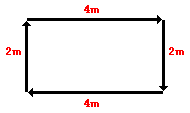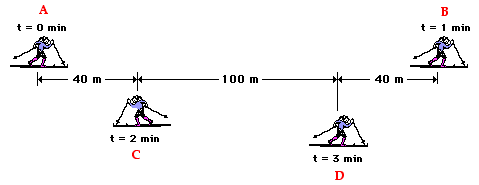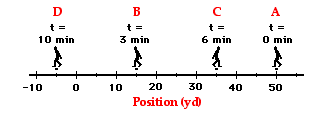Distance can be defined as total length of the path travelled by the object. For example red line indicates the distance.

Displacement may be defines as the difference between initial and final point of a distance travelled by the object. For example

- 1
Following are the differences between distance and displacement:
1. Distance is the length of the path travelled by a body while moving from an initial position to a final position; Displacement is the shortest distance between the initial position and the final position of the body.
2. Distance is a scalar quantity; Displacement is a vector quantity.
3. Distance measured is always positive; Displacement can be positive or negative depending on the reference point.
4. The total distance covered is equal to the algebraic sum of all the distances travelled in different directions. The net displacement is the vector sum of the individual displacements in different directions.
5. There is always a distance covered whenever there is a motion; Displacement will be zero if the body comes back to its initial position.
Suppose you are observing an ant on the table, as shown in the diagram below. The ant moves from one corner of the table to the other corner. The blue irregular line shows the path of the ant.

Length of this blue line is the distance covered by the ant.
The straight green line, which is the minimum distance between the two corners of the table is the displacement of the ant.
![]()
- 1
Distance and displacement are two quantities that may seem to mean the same thing yet have distinctly different definitions and meanings.
- Distance is a scalar quantity that refers to "how much ground an object has covered" during its motion.
- Displacement is a vector quantity that refers to "how far out of place an object is"; it is the object's overall change in position.
To test your understanding of this distinction, consider the motion depicted in the diagram below. A physics teacher walks 4 meters East, 2 meters South, 4 meters West, and finally 2 meters North.

Even though the physics teacher has walked a total distance of 12 meters, her displacement is 0 meters. During the course of her motion, she has "covered 12 meters of ground" (distance = 12 m). Yet when she is finished walking, she is not "out of place" - i.e., there is no displacement for her motion (displacement = 0 m). Displacement, being a vector quantity, must give attention to direction. The 4 meters east cancels the 4 meters west; and the 2 meters south cancels the 2 meters north. Vector quantities such as displacement are direction aware. Scalar quantities such as distance are ignorant of direction. In determining the overall distance traveled by the physics teachers, the various directions of motion can be ignored.
Now consider another example. The diagram below shows the position of a cross-country skier at various times. At each of the indicated times, the skier turns around and reverses the direction of travel. In other words, the skier moves from A to B to C to D.
![]() Use the diagram to determine the resulting displacement and the distance traveled by the skier during these three minutes. Then click the button to see the answer.
Use the diagram to determine the resulting displacement and the distance traveled by the skier during these three minutes. Then click the button to see the answer.

As a final example, consider a football coach pacing back and forth along the sidelines. The diagram below shows several of coach's positions at various times. At each marked position, the coach makes a "U-turn" and moves in the opposite direction. In other words, the coach moves from position A to B to C to D.
![]() What is the coach's resulting displacement and distance of travel? Click the button to see the answer.
What is the coach's resulting displacement and distance of travel? Click the button to see the answer.

To understand the distinction between distance and displacement, you must know the definitions. You must also know that a vector quantity such as displacement is direction-aware and a scalar quantity such as distance is ignorant of direction. When an object changes its direction of motion, displacement takes this direction change into account; heading the opposite direction effectively begins to cancel whatever displacement there once was.
- 1

